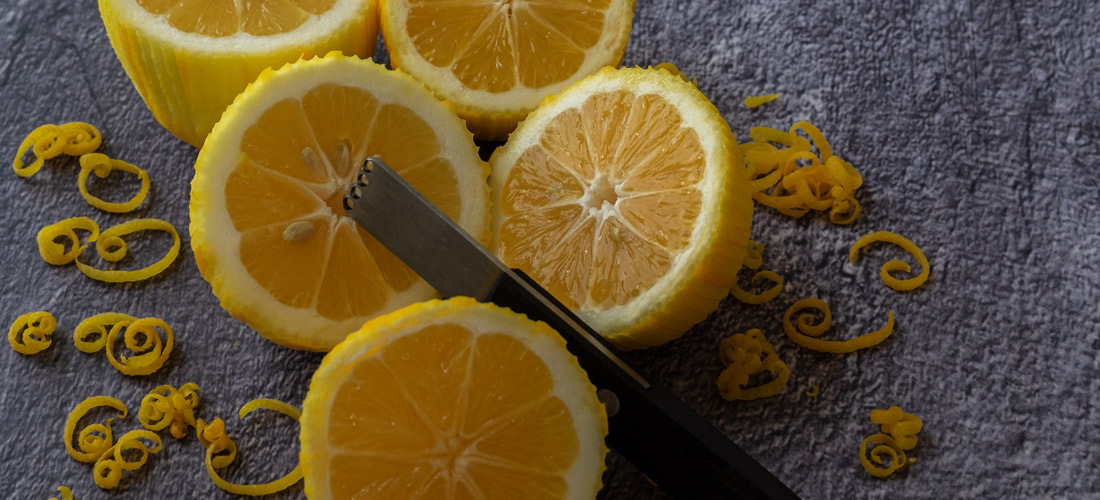Blueberry, Lemon and Fresh Thyme Jam
- Jams, Jellies & Marmalades
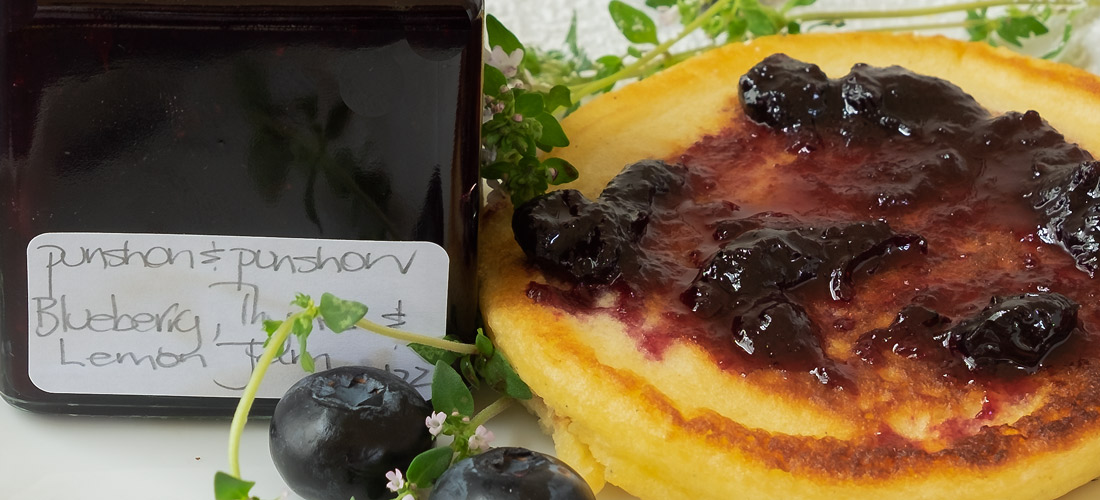
Blueberry jam, scented with fresh aromatic lemon and thyme, is a majestic preserve that deserves to be savoured and shared with the special folk in your life. This recipe, with its mashing and macerating technique, that creates a truly delicious intense purple coloured jam, will seduce even the most fastidious jam lover.
If you grow blueberries, you’ll need a few bushes to be able to harvest enough to make a batch. Picking extra is a must as it’s just toooo tempting to eat as many that go into the bowl. Our soil isn’t acidic enough to grow this super berry, so only small batches are cooked up when the berries are in full season and at a great price. Enjoy one of life’s little luxuries and make a batch today.
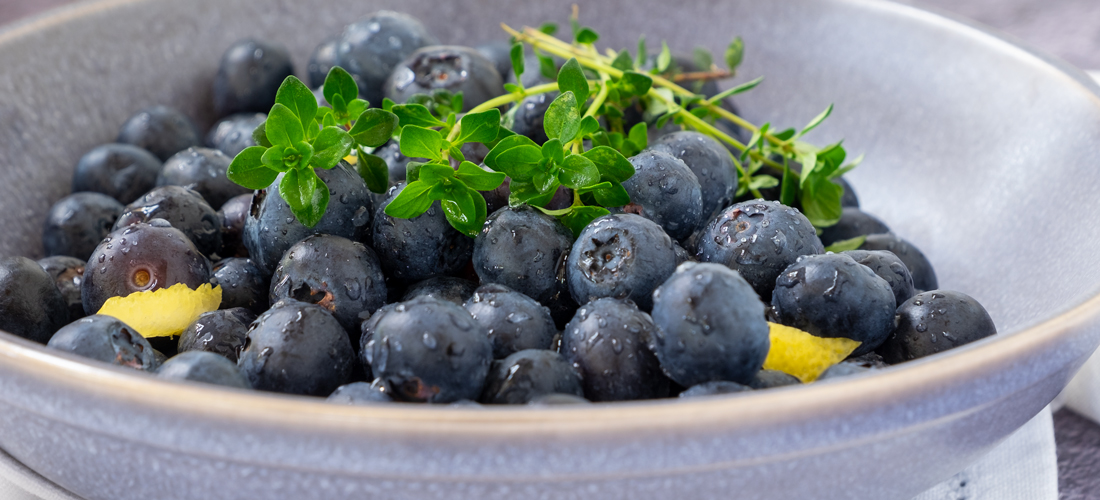
- Preparation Time:
- 15 minutes
- Cooking Time:
- 20 minutes
- Quantity:
- 2 x 200ml jars
INGREDIENTS
- 400gm
- Blueberries, fresh
- 300g
- Sugar, white
- 3
- Lemons, juice and rind
- 8 stems
- Thyme, fresh
- 100 ml
- Water
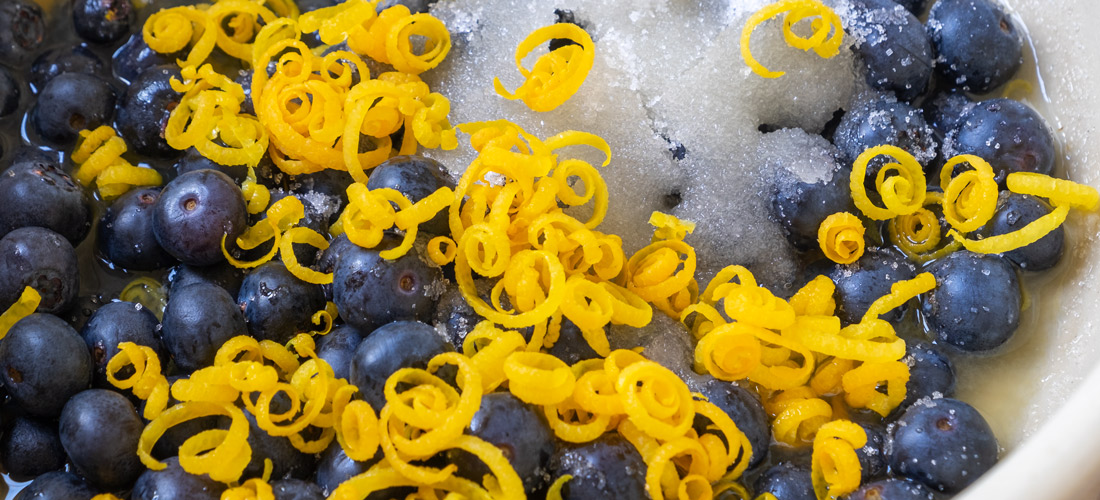
METHOD
Gently wash and remove the stem from the blueberries. Remove excess moisture by gently patting dry or allow to rest on paper towel or a clean dry tea towel.
Place all berries, lemon juice and half the sugar (150g) into a large metal or ceramic bowl. Using a potato masher, lightly crush the berries so there is a mixture of whole, large, and small fruit pieces. Cover with a tea towel and allow the mixture to sit for at least 4 hours. The sugar will draw out the colour, flavour, and moisture from the berries.
Wash the thyme and remove the leaves from the stalk. Finely chop the leaves and discard the stalk. Place the crushed berry mixture, finely grated lemon zest, water and chopped thyme into a preserving pan or large heavy bottomed stainless-steel pot.
Bring to the boil and simmer gently with the lid on until the blueberry skins are soft.
Add the remaining sugar (150g), bring to the boil, stirring occasionally to dissolve the sugar. Then boil rapidly until the jam reaches its setting point or 105 degrees C (220 degrees F). Skim as required, using a sharp-edged spoon or ladle, to remove the scum that accumulates around the edge of the pot. Beware of hot spluttering jam – it can easily burn uncovered arms and hands.
Carefully stir occasionally to prevent the fruit from sticking to the bottom of the pot.
Remove from the heat, place on a heat resistant surface and allow to sit for 5-10 minutes. As the jam begins to cool, the fruit will settle evenly through the jar. If bottled immediately it’s likely the fruit will rise from the bottom of the jar.
Using a wide-necked funnel, ladle into warm sterilised jars, to within 2.5 cm (1 inch) from the top, distributing the fruit evenly between the jars.
Cover with sterilised lids or with melted paraffin wax while the jam is still hot. If sealing with wax, once it has set, cover with cellulose or plastic film and secure with a rubber band or string.
Alternatively allow jam to cool completely and seal with a screw top lid or cellophane paper.
The hot method of sealing is preferred as there is reduced risk of contamination prior to sealing. A vacuum seal will also be created as the jam cools down when the lid is screwed on tightly.
-
Label and store in a cool dark place in the kitchen or pantry.
Allow the jam to mature for at least 2 weeks before eating.
NOTES
- Blueberries have a low pectin and acid content and require the addition of lemon juice to produce a set. Refer to my post, What Makes Jam, Jelly, Marmalade Set, to understand how preserves set. It also contains a handy Acid and Pectin Chart so you can get even your most creative combinations to set.
- Choose ripened clean berries. Do not use overripe and never use mouldy fruit as this will produce a poor-quality jam. Substituting dried thyme for fresh thyme is not recommended as it can have a harsh and slightly bitter flavour.
- If you don’t have a preserving pan, use a large heavy bottom pot, preferably stainless steel. This will distribute the heat evenly across the pan and the jam while it is cooking. Ensure there is enough space available in the pot for the mixture to double in size while it is rapidly boiling.
- Mashing the fruit creates a mixture of whole and pulpy fruit which creates a more interesting and spreadable jam texture. Some fruits such as blueberries, benefit from this technique, otherwise the berries will remain whole during the cooking process resulting in whole suspended fruit in a syrupy base. Mashing with a potato masher or fork is recommended over using a food processor, as it is very easy to over-process the fruit which creates a mushy texture or overly smooth final jam texture.
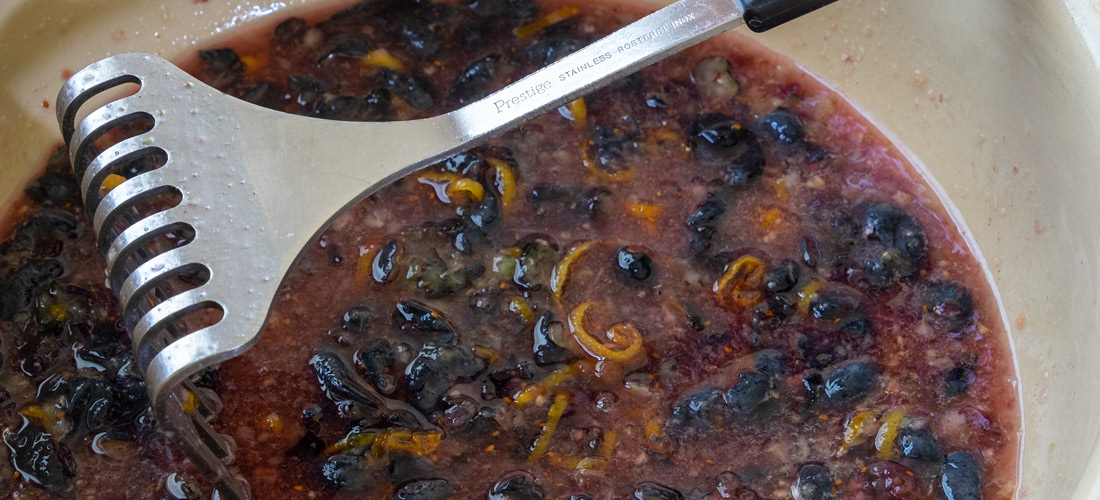
- To warm the sugar put the recipe quantity in an oven proof container and place in a preheated oven to 150 degrees C for approximately 10 minutes. The sugar should be warm throughout the bowl. Warmed sugar dissolves quickly and a rapid boil until the setting point is reached helps to preserve the fresh citrus flavour.
- Ensure the sugar has completely dissolved before boiling otherwise the sugar may crystallise later in the jar.
- Rapidly boil the jam until it reaches the setting point, stirring occasionally to prevent the jam from sticking on the bottom of the pot. But not too often as this will lower the temperature and delays reaching the setting point. Long slow simmering at this point will reduce the colour and flavour.
- Cooking times are an approximation only. They are provided as a guideline as cooking times are influenced by the type of pot and its diameter and height, speed of cooking and fruit ripeness, size and moisture level.
- If for some reason a jam doesn’t set don’t discard it. It can either be re-boiled to reach its setting point or used as a delicious sauce to accompany cake, dessert or spooned lovingly over ice-cream.
- Removing the scum
- Jam, jellies, and marmalades can produce a scum while they are boiling. Impurities from the fruit and sugar will rise to the surface and a fine frothy foam will move towards the edge of the preserving pan. Some fruits will produce more scum that others.
- This is a natural self-clarification process and makes the task of making a high-quality preserve easier. Removing the scum increases the preserve’s clarity. This is very important if it is being submitted for competition. Remove the scum before bottling. Using a stainless-steel spoon, skim the scum from around the edge of the preserving pan. Be careful to remove just the scum and not the jam. This can be done while the jam is boiling and/or once it has been taken off the heat. Do not attempt to remove the scum from the centre of the boiling jam, as there is an elevated risk the jam will splutter and hot jam burns.
- Using paraffin Wax
- Paraffin wax is available in speciality preserving stores and some rural hardware stores.
- The melted wax must be poured over the preserve while it is hot.
- Break the wax into small pieces and heat in a bowl set over a pan of hot water. Bring to the boil, reduce the heat to maintain a gentle simmer until the wax is just melted.
- Do not overheat. If it gets too hot it will shrink away from the sides of the preserving jar as it cools. This will break the seal and allow impurities to access the contents, encouraging mould growth.
- Working quickly pour a thin layer over the hot preserve. Using a small wooden cocktail stick, toothpick, or cake skewer, prick any air bubbles.
- Allow the wax to set. Then pour a second thin layer to make a seal approximately 3mm thick.
- When the wax has set it will become opaque and dip slightly in the middle.
- To use the preserve, break the wax seal and remove.
- Cover the jar with clear film and store in the fridge.
- Sealing with wax is not a long-term solution. Use within a couple of months
- Variations
- Can be made without the fresh thyme
- A combination of other soft berries can be used to create a delicious mixed berry jam. The lemon juice is an essential ingredient as berries are low in pectin and acid and the lemon juice will help it to set.
